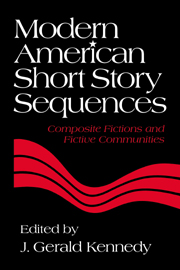Book contents
- Frontmatter
- Contents
- Contributors
- Introduction: The American Short Story Sequence – Definitions and Implications
- Henry James's Incipient Poetics of the Short Story Sequence: The Finer Grain (1910)
- Toomer's Cane as Narrative Sequence
- Hemingway's In Our Time: The Biography of a Book
- Wright Writing Reading: Narrative Strategies in Uncle Tom's Children
- The African-American Voice in Faulkner's Go Down, Moses
- Meditations on Nonpresence: Re-visioning the Short Story in Eudora Welty's The Wide Net
- Nine Stories: J. D. Salinger's Linked Mysteries
- Cheever's Shady Hill: A Suburban Sequence
- John Updike's Olinger Stories: New Light Among the Shadows
- Louise Erdrich's Love Medicine: Narrative Communities and the Short Story Sequence
- From Anderson's Winesburg to Carver's Cathedral: The Short Story Sequence and the Semblance of Community
- Index
From Anderson's Winesburg to Carver's Cathedral: The Short Story Sequence and the Semblance of Community
Published online by Cambridge University Press: 29 September 2009
- Frontmatter
- Contents
- Contributors
- Introduction: The American Short Story Sequence – Definitions and Implications
- Henry James's Incipient Poetics of the Short Story Sequence: The Finer Grain (1910)
- Toomer's Cane as Narrative Sequence
- Hemingway's In Our Time: The Biography of a Book
- Wright Writing Reading: Narrative Strategies in Uncle Tom's Children
- The African-American Voice in Faulkner's Go Down, Moses
- Meditations on Nonpresence: Re-visioning the Short Story in Eudora Welty's The Wide Net
- Nine Stories: J. D. Salinger's Linked Mysteries
- Cheever's Shady Hill: A Suburban Sequence
- John Updike's Olinger Stories: New Light Among the Shadows
- Louise Erdrich's Love Medicine: Narrative Communities and the Short Story Sequence
- From Anderson's Winesburg to Carver's Cathedral: The Short Story Sequence and the Semblance of Community
- Index
Summary
If the sense of community “begins with, and is very largely supported by, the experience of interdependence and reciprocity,” as Philip Selznick observes, then the modern short story sequence poses a provocative analogy to this basic social structure. Assembling narratives about diverse characters to form a composite text, such collections curiously resemble the gathering of a group to exchange the stories that express its collective identity. Whether or not fictional protagonists narrate their own accounts, their juxtaposed experiences disclose connections that apparently link their lives to a larger scheme of order and meaning. The analogy between communities and story sequences becomes inescapable in works such as The Country of the Pointed Firs, Dubliners, Tortilla Flat, or Olinger Stories – all of which represent specific population groups or identified enclaves. Sherwood Anderson's Winesburg, Ohio epitomizes this local emphasis insofar as it maps a town and surveys its populace, yielding a panoramic view of its collective life. In a broad sense, the mixed voices and multiple perspectives in these self-conscious “narratives of community” expose the element of communal dialogue inherent in all short story sequences.
Yet, as a written artifact, a product of print culture, the story sequence always assumes an ironic relation to the scene of communal narration that it obscurely simulates. In a much-quoted essay, Walter Benjamin has lamented the recent decline of “the art of storytelling” – the accumulation of narrative density through repeated recitation – noting that the modern short story has already “removed itself from oral tradition.” Much earlier, in Sketches from a Hunter's Album, Turgenev had depicted the same break with orality, projecting the short story writer's loss of community.
- Type
- Chapter
- Information
- Modern American Short Story SequencesComposite Fictions and Fictive Communities, pp. 194 - 216Publisher: Cambridge University PressPrint publication year: 1995
- 4
- Cited by



